Magic seed and nut loaf
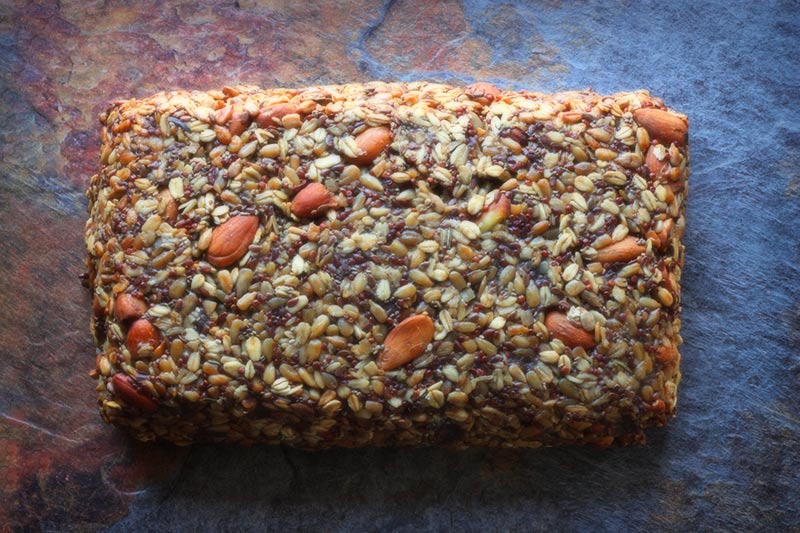
As I mentioned recently, I’ve significantly reduced my gluten intake. I’ll save a more detailed account of the positive effects of this change (along with other dietary tweaks I’ve made) for a future post, but suffice it to say, me likey. A lot.
And searching for bread substitutes has lead to some really neat discoveries, like today’s recipe — “bread” made of seeds and nuts, held together by a secret ingredient.
The basis of this recipe comes from Sarah Britton of MyNewRoots.org, which she quite apty named “Life-Changing Bread.” For folks who are completely gluten-free, this is one amazing substitute, and quite a lovely change from breads made with GF flours (which can produce off-tasting results, or, in the case of nuts flours, calorie bombs that leave me cringing at the math).
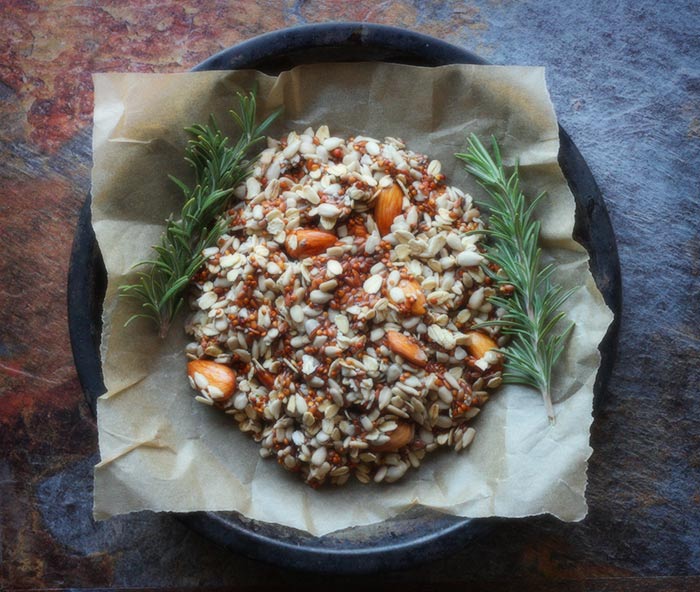
I’ve held off blogging about this recipe because Sarah’s post covers it so well. But I’ve made one tweak to the recipe that I think makes it worth posting anew.
Last year, I jumped on the sprouts bandwagon, and have been sprouting seeds and nuts regularly ever since. Their health benefits are considerable, and it’s an easy kitchen project that takes only minutes a day.
Sprouting seeds and nuts turns the little darlings into living foods, kick-starting enzyme activity that awakens the seed or nut in prep for growth, and increases mineral and protein content by a substantial margin. Simply put, a sprouted seed or nut is far healthier than one that’s not.
Sprouting also makes the seeds and nuts easier to digest, supplying the body with a highly-absorbable protein in the process.
A simple overnight soaking is sufficient to awaken the seeds and nuts to infuse this already wonderful loaf with the health benefits of sprouting.
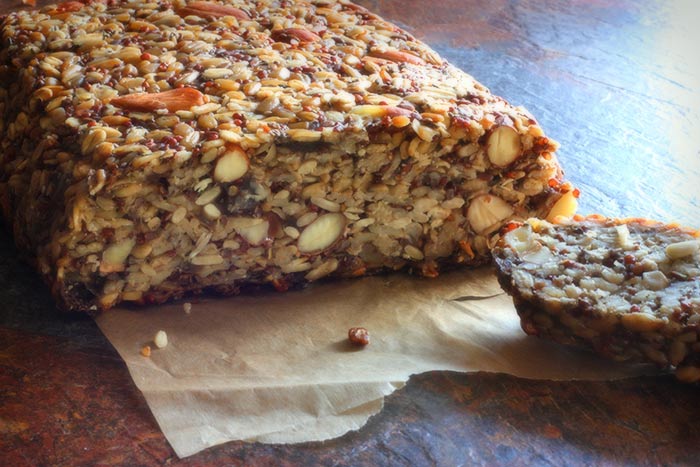
Now, about that magic ingredient. Actually, there are three.
The first two come thanks to the overnight soak (a benefit that would otherwise be absent). Flaxseed and chia seeds become gelatinous when soaked in water. The thick gel they produce helps to bind the other nuts and seeds together.
The third is an ingredient I never would’ve thought to use in a million years: psyllium husks. Psyllium husks are quite effective in keeping — how shall I say — our internal elimination processes regulated. The primary ingredient in Metamucil, psyllium husks provide a significant dose of soluble fiber, which we all know is critical for good health.
When dissolved in water, psyllium husks become a crazy thick and viscous goo — a natural binding agent if there ever was one. Folded thoroughly into the nuts and seeds, the psyllium husks will glue everything together once baked, adding its own fiber health benefits with no weird flavor contribution.
A loaf of “bread” with mineral and protein rich seeds and nuts, loaded with soluable fiber.
And so tasty to boot — sliced, it makes the most amazing toast and is just begging to be smeared with your favorite preserves and spreads.
It’s magic.
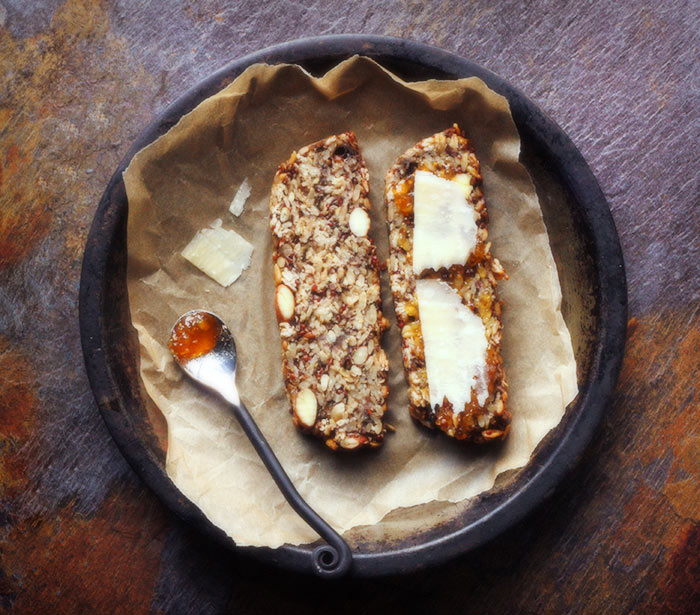
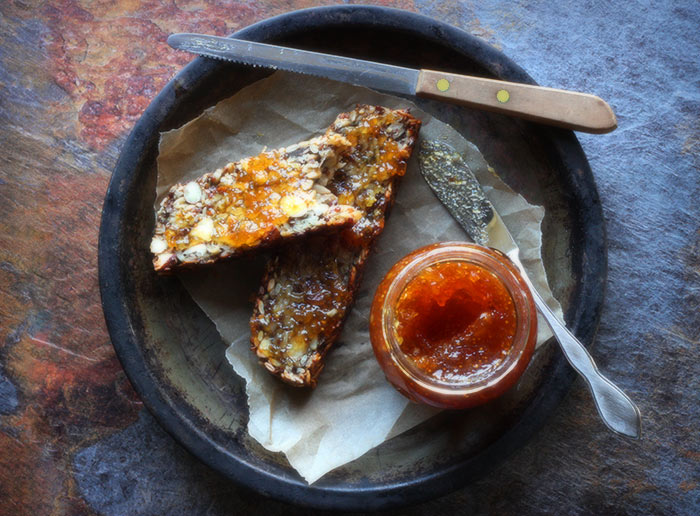
Magic seed and nut loaf
adapted from Sarah Britton of MyNewRoots.org
Psyllium husks are readily available in most health food and grocery stores. Both the whole husk and powder forms work well in this recipe.
Ingredients
- 1 cup raw sunflower seeds
- 1/2 cup raw almonds or hazelnuts
- 1/4 cup uncooked quinoa (any color)
- 1/4 cup flaxseed
- 2 tablespoons chia seeds
- 1 tablespoon hemp hearts
- 1 1/2 cups rolled oats
- 1 tablespoon rosemary, minced
- big pinch salt
- 4 tablespoons psyllium seed husks (3 tablespoons if using psyllium husk powder)
- 1 tablespoon honey or maple syrup
- 3 tablespoons melted coconut oil or ghee
- 1 1/4 cups hot water
Instructions:
- The night before, place the sunflower seeds, almonds, quinoa, flaxseed, chia seeds, and hemp hearts in a large bowl cover with fresh water by 2 inches.
- The next day, when ready to bake, drain and rinse the seeds and nuts in a large fine-mesh sieve (do this in batches, if you have to). Return to the bowl, and stir in the rolled oats, rosemary, and salt, and set aside.
- In a medium bowl, combine the psyllium husks, honey, and oil/ghee, and whisk until very thick. Add the water, continue stirring (switch to a spoon if the mixture is too viscous for a whisk).
- Scrape the psyllium husk mixture into the seed and nut mixture, and fold, combining well. Oil a loaf pan, and line with parchment paper, leaving “handles” hanging over two of the edges. Spread the mixture in the loaf pan, smoothing out the top as best you can. Let rest for 2 hours.
- Meanwhile, preheat the oven to 350°F, and set a rack in the middle position.
- Bake for 20 minutes. Gently lift the bread from the pan using the parchment handles, and set the loaf on a baking sheet. The loaf is very fragile at this point – avoid picking it with your hands, as the loaf could crack in the middle. Invert a cooling rack on top of the loaf, and gently flip the whole shebang, so the loaf is top-side down on the cooling rack. Remove the baking sheet and the parchment paper. Place the loaf and cooling rack back into the oven, and bake for another 30 to 50 minutes. Begin checking the loaf at 30 minutes: the nuts and seeds should toast to a golden brown on the outside (but not to black). The loaf is done when it sounds hollow when tapped. (If the nuts are browning faster than the bread is sounding hollow, err on the side of a shorter baking time. The loaf will set when cooled.)
- Let the loaf cool completely before cutting – it will break apart if you don’t. Use a sharp serrated knife to cut thick slices.
- For the most tasty results, toast slices in the toaster before serving.

Comments:
Comments are closed.








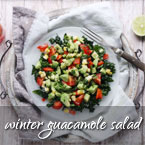



This recipe looks so cool. I’m not GF, but I just love trying out cool recipes to try. It always amazes me what plant foods can do! Where can you get those psyllium husks?
Ya know, I never registered the psyllium husk containers before this recipe, but now I see them everywhere! I’ve seen them in a couple of places – check the vitamin aisle, or, the laxative/antiacid aisle. I bought mine at a health food store (they were in the vitamins sections, in a regular vitamin-looking bottle). I’ve also seen them in grocery stores, in the laxative aisle, in a container that resembles the Quaker Oats cardboard tube. Oh, and possibly in the natural foods section of grocery stores, too.
I am so glad you tackled this one – I have had this recipe bookmarked over on that site (and have the ingreidents sitting in my pantry) but was hestiant to give it a try – because – well – I couldn’t get past the lack of flour?
It really is a lovely loaf.
It holds together incredibly well, but is not stretchy or chewy at all (which, working with psyllium husks for the first time, made me raise a skeptical eyebrow at the sheer viscosity of the mixture). It’s totally built for spreads, sweet or savory. A little fig jam, a slice of aged cheese – a delicious little snack.
We must be on the same wavelength because I’ve just started getting into sprouting nuts and seeds too. In fact, I’m eating only raw foods and juices for the next week, so I’ve been eating a LOT of sprouted things these past few days. This loaf is gorgeous!
This loaf is gorgeous!
My two favorite discoveries of the past year: sprouts and juice. Good luck with the eating plan – I bet you’ll feel great at the end of it!
I made this bread just a few weeks ago! I loved it so much because of it’s super hearty and nutty flavor and it also kept fresh for a long time. I usually toasted the individual slices a bit before eating, which kind of roasted the seeds and made it extra crunchy and yummy. Surprisingly, we found the psyllium husk immediatly upon walking into our local Whole Foods (it was literally set up in a stacked mountain by the entrance) and I always keep seeds and sprouts around the house.
I also LOVE growing my own sprouts! I use them in sandwiches and salads and they are super cheap in comparison to the store bought variety. I use a sprouter (a jar with a mesh lid) which makes the whole processs extremely east. It took me some time to track down a place where I could buy the seeds though. Personally, I order them online now ( at a place called iherb.com, there is a coupon code that gives you 10$ off your first purchase: BUY183 ).
It really only takes a few days for the sprouts to grow, if I set the sprouter up on Monday, I’ll hav eplenty off sprouts to eat by the time the weekend rolls around.
How many calories does this loaf have? Just wondering if it is comparable to a slice or bread or more calories with all the nuts and seeds in it.